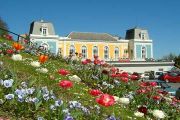 |
 |
Well-being and thermal water in Bagnères |
 |
Bagnères-de-Bigorre is the main spa resort of the Hautes Pyrénées department, and boasts a thermal bath as well as a modern well-being centre. It is also a picturesque town with a number of ancient buildings located at the foot of the mountains.
[ Practical ]
Getting there
- By road
815 km from Paris on autoroutes A6a and A10 till Orléans, then on A20 and A62 till Toulouse, then on A614 and A64 till Bagnères-de-Bigorre.
- By train
TGV from Paris Montparnasse to Tarbes. Journey takes approximately 6 hours.
Night train from Paris Austerlitz to Tarbes. Duration of the journey : 9 hours.
Bus from Tarbes to Bagnères de Bigorre. Duration of the journey : 35 to 45 mn.
- By plane
Air France has two flights per day between Paris Orly and Tarbes.
Lodging
- Hotels
Relais des Pyrénées
Hôtel Le Tivoli
Hôtel des Pyrénées
Hôtel Saint-Vincent
Hostellerie d’Asté in Asté, 4 km from Bagnères
- Bed and Breakfast
Villa Rose
Les Petites Vosges
Maison Burret in Montgaillard, 8 km from Bagnères
Restaurants
L’Atelier
L’Auberge Gourmande
Hostellerie d’Asté
Hôtel Saint-Vincent
Aquensis
Admission to the relaxation area : €16
Cares from €28
Tel : 0562958695
www.aquensis.fr
Information
- Hautes Pyrénées Tourist Office
Tel : 0562567065
www.tourisme-hautes-pyrenees.com
- Bagnères de Bigorre Tourist Office
Tel : 0562955071
www.grand-tourmalet.com
“Athens of the Pyrenees” was the lofty tag given to Bagnères-de-Bigorre in the 19th century. At that time, many artists and aristocrats made their way to the small town of 8,000 inhabitants located in the Adour valley at the foot of the mountains, near the mythical passes of Aspin and Tourmalet. Lamartine, Flaubert, George Sand, Rossini, Anthony Russel and many other celebrities came to the town to take advantage of the thermal waters renowned for their analgesic, antispasmodic and relaxing virtues.

 Casino © CRT Midi-Pyrénées Casino © CRT Midi-Pyrénées
|
 Social and cultural hotspot Social and cultural hotspot
This fame made the town one of France’s social and cultural hotspots at the end of the 19th century and the Belle Epoque.
The healing properties of the Bagnères’ waters have been known since Ancient times. Altars erected by the Gauls in praise of the god of “Good Waters” and the remains of baths built by the Romans both bear testimony to a long tradition. Following a decline in the Middle Ages, spa activities enjoyed a revival during the Renaissance period and later attracted famous patients such as Henri IV, originally from Bearn, the writers Rabelais and Montaigne, Madame de Maintenon and Napoleon.
Today, more than 8,000 patients come to take the water every year as a treatment against anxiety, rheumatism, psychosomatic and respiratory diseases. Reimbursed by the French welfare system, the Securité Sociale, these treatments are taken in the Grands Thermes, a beautiful 19th century neoclassical building.
 Warm and welcoming ambiance Warm and welcoming ambiance
In addition, a modern fitness and well-being centre was built in the town in 2003. Dubbed Aquensis, in reference to the town’s old Roman name, Vicus Aquensis, the centre is located in a 19th century building with a blue pastel façade next to the casino. It has the advantage of being able to utilize the same resource as the Grands Thermes: thermal water at a temperature of 48 – 50 °c captured at a depth of 200m and rich in trace elements, calcium, sulphate and magnesium. The original interior architecture is still clearly evident in the entrance hall, with the rest of the building giving way to a more modern style combining wood, glass and local marble. The result is a warm, welcoming ambiance bathed in natural light spilling through a glass roof.
Aquensis consists of three areas. The first, the relaxation area, is arranged around a large pool equipped with water curtains, underwater jets, whirlpool baths and counter-currents that delight young and old alike.
 Individual cares Individual cares
For an even more peaceful setting, there is a smaller pool with underwater music designed for pure relaxation. It also boasts numerous hydro massage devices and there are regular aqua gym classes. Near these two pools, you will find two Finnish saunas, a hammam with oriental decor and a tea room. Lastly, two jacuzzis and a solarium are situated on the roof of the building on a wood-panelled terrace offering an excellent view of Bagnères and the surrounding area.
Situated on a large wooden balcony overlooking the grand bassin, the well-being area offers a wide array of individual treatments lasting from 20 min to 1 hour 30 min: whirlpool bath, draining jet shower, clay mud poultice, wrapping, anti-age treatments, physiotherapist massages, oriental treatments, as well as aesthetic facial and body treatments using Sothys products.

 Saint Vincent church © CDT 65 Saint Vincent church © CDT 65
|
 Many remnants of the past Many remnants of the past
The centre also offers treatments that use local products: baths in donkey milk, marble powder scrubs and massages using organic essential oils developed in partnership with the Botanical Conservatory of the Pyrenees.
Lastly, there is a fitness area comprising a gymnasium which offers group classes for stretching, step, gym, etc. A weights room has equipment for strengthening or developing muscles under the supervision of certified instructors.
Aside from hydrotherapy, Bagnères-de-Bigorre has other hidden charms and has managed to preserve many remnants of its past. Some half-timbered houses, traditional 17-18th century local houses with high, narrow facades, a tower which is the last remaining remnant of a 14th century Dominican convent, the Saint Vincent church, a gothic monument with a beautiful Renaissance portal to name but a few.
 Marble museum Marble museum
Worth a visit too is the city hall housed in a 19th century villa, boasting a marble-clad façade. Marble is a common rock in the area and was mined locally until the 1980s. In the heart of a peaceful English-style park covering 100 ha, the Vallon du Salut marble museum traces the history of the quarrying of this rock, with 320 varieties on view. It is situated in the former 18th century Thermes du Salut that also houses the Natural History Museum. As for art lovers, there is the Salies Fine Art Musuem that houses paintings, watercolours and sculpture, or try out the many artists’ workshops in the town. And once your stroll has come to an end, there is nothing better than a drink on a café terrace under the lime blossoms of the Allée des Coustous.
October 17, 2009
Hélène Tilliette 

|
|
 |

|
 |



